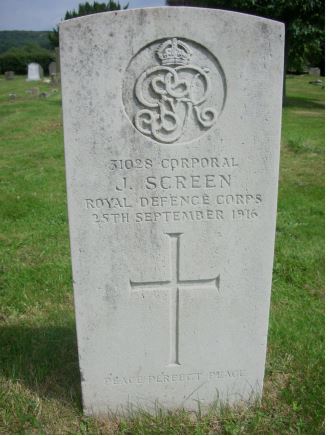109th Protection Company, Royal Defence Corps

According to Leaving All that was Dear – Cheltenham and the Great War by Joe Devereux and Graham Sacker, John Screen was an ex-soldier of the regular Army, having served as a sergeant in the 2nd Battalion of the Gloucestershire Regiment during the South African War, being awarded the Queen’s Medal with three clasps.
The release of Royal Hospital Chelsea Pensioner Soldier Service Records 1760-1920 (National Archives ref WO97/1278-4287) confirms that he originally attested for military service on 10 March 1887, aged 18 years and one month, having previously been a labourer. He initially signed up for 7 years plus 5 in the Reserve and joined the Gloucestershire Regiment and was given the number 2071. He served, with the 2nd Battalion, in the UK from 10 March 1887 to 5 December 1889 and was in India from 6 December 1889 until 28 November 1894. A further period of UK service followed, until 11 June 1900, following which he was in South Africa until 3 December 1903. He returned to the UK and served there until discharged, as medically unfit for further service, on 24 November 1904. His period of engagement had been extended and he finished as a Serjeant after 17 years’ service.
John Screen was born in Berkeley, Gloucestershire in 1869 and in 1907 he married Clara Elizabeth Woodward, in Cheltenham and by the time of the 1911 Census the couple had produced three children, one having died in infancy. The census return confirmed John’s status as an Army Pensioner. The family address was 20 Bloomsbury Street, Cheltenham.
Soon after war was declared, on 24 September 1914, Sergeant Screen, applied to join the Army Reserve (Special Reserve) for one year’s service, stating his occupation to be a labourer, his previous military service with the 2nd Glosters (Life Pensioner), his residence (above address) and marital status, with two children. At the age of 45 he was too old for overseas service but, being considered physically fit; he was enlisted as a Drill Instructor and posted to the 8th Battalion of the Glosters on 8 October 1914. His regimental number was 3101. Twenty-two days after enlisting he was discharged as ‘not being likely to become an efficient soldier’.
His surviving papers do not record his transfer to the 109th Protection Company. Such companies were formed of soldiers who were either too old or unfit for active service but were capable of participating in guard duties, thus freeing up fitter men for more active duties. Possibly, still keen to serve, John Screen was offered such a role. The Protection Companies were absorbed into the newly formed Royal Defence Corps in March 1916.
John Screen died of illness at Abbey Wood, Kent (south east London) on 25 September 1916, aged 46 and was buried in Cheltenham Cemetery, where a CWGC headstone marks his grave. A recently released Pension Record Card states that he died from a pulmonary haemorrhage and heart failure, whilst on active service. He is commemorated on the Cheltenham Borough War Memorial, where it notes he was a soldier of the Gloucestershire Regiment.
Researched by Graham Adams 6 February 2013 (revised 8 August 2021)
